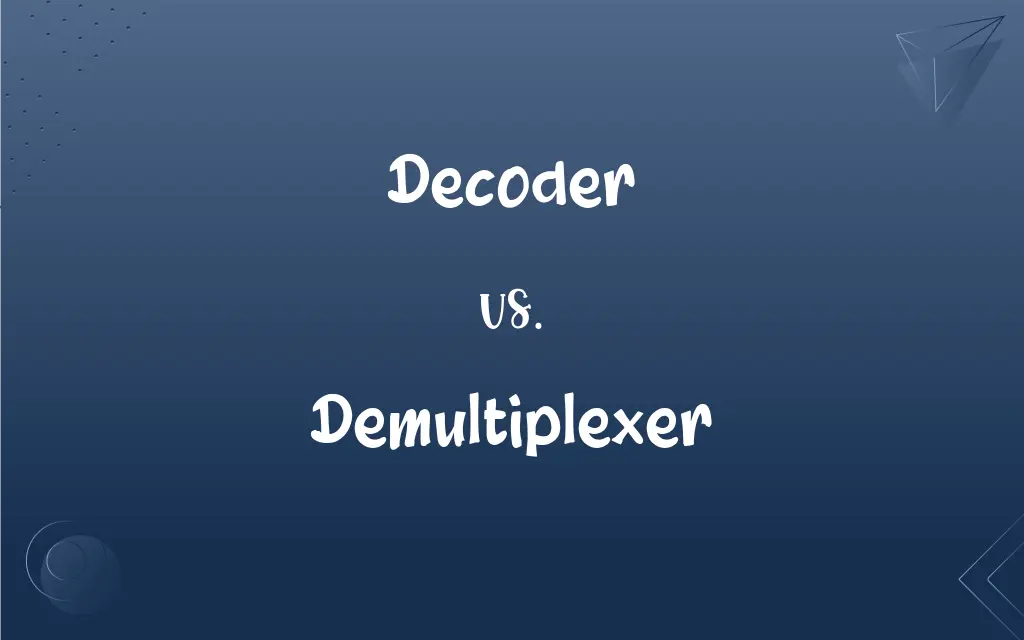Decoder vs. Demultiplexer: What's the Difference?
Edited by Aimie Carlson || By Janet White || Published on February 29, 2024
A Decoder translates coded data into understandable form, while a Demultiplexer takes a single input and selects one of many data-output-lines.

Key Differences
A Decoder is a device or program that converts coded data into a comprehensible form. It's essential in systems where data transmission and storage occur in an encoded format for efficiency or security. On the other hand, a Demultiplexer, often abbreviated as DEMUX, is used in digital circuits to route a single input line to one of several output lines. Its primary function is to direct data from one source to multiple destinations.
Decoders are integral to systems like communication receivers and multimedia playback, where they interpret signal formats or data streams. They transform encoded data or signals back to their original form. Demultiplexers, in contrast, are crucial in systems where multiple signals or data streams need to be routed through a single channel, efficiently managing multiple outputs.
The working principle of a Decoder involves interpreting binary data, whereas a Demultiplexer relies on selector pins to choose the specific output line. For example, in digital broadcasting, a decoder translates the received encoded signal into audio and video formats. In contrast, a Demultiplexer in a digital system may direct data from a single source to different components, such as directing a digital signal to various display units.
The complexity of Decoders varies depending on the data or signal complexity they are designed to interpret. High-definition multimedia decoders are more complex than simple binary decoders. Demultiplexers, on the other hand, have a more straightforward operation but are essential in complex digital systems for routing signals or data accurately.
Both Decoders and Demultiplexers are fundamental in digital systems, their roles are distinctly different. Decoders are about interpretation and conversion of data, crucial for communication and media systems. Demultiplexers, however, are about selection and routing of data, playing a key role in digital circuit design and signal distribution.
ADVERTISEMENT
Comparison Chart
Primary Function
Converts coded data into an understandable form.
Routes a single input to one of multiple outputs.
Usage Example
Used in multimedia systems to decode data streams.
Used in digital circuits for signal routing.
Working Principle
Interprets and converts binary data or signals.
Selects an output line based on control signals.
Complexity
Varies, often complex for multimedia applications.
Generally simpler, focused on data routing.
Role in Digital Systems
Essential for data interpretation and conversion.
Crucial for efficient signal distribution.
ADVERTISEMENT
Decoder and Demultiplexer Definitions
Decoder
A Decoder translates encrypted data into a readable format.
The satellite TV decoder converts the received signal into watchable content.
Demultiplexer
A Demultiplexer can select and transmit data to one of many paths.
The video broadcast system uses a demultiplexer to route signals to different channels.
Decoder
Decoders interpret binary signals into understandable information.
In our computer system, the decoder interprets the binary code into user-friendly data.
Demultiplexer
Demultiplexers are essential for managing multiple data streams in networks.
To handle multiple camera feeds, our security system uses a demultiplexer.
Decoder
Decoders are used in digital electronics to decode encoded inputs.
The barcode scanner's decoder interprets the barcode into product information.
Demultiplexer
Demultiplexers are used for distributing one input over several outputs.
The satellite receiver's demultiplexer allocates signals to various transponders.
Decoder
Decoders are used to revert compressed data to its original form.
Streaming services use decoders to play compressed video files smoothly.
Demultiplexer
Demultiplexers are used in digital circuits for efficient signal routing.
In our control system, the demultiplexer directs the signal to the correct actuator.
Decoder
A Decoder is essential in telecommunications for signal interpretation.
Decoders in mobile phones convert incoming digital signals into voice and text messages.
Demultiplexer
A Demultiplexer distributes a single input signal into multiple output lines.
The demultiplexer in our network splits the data stream to various servers.
Decoder
One that decodes.
Demultiplexer
A device or piece of software used to separate signals that were previously combined using a multiplexer.
Decoder
A device that decodes a scrambled electronic signal to make it interpretable.
Decoder
A person who decodes secret messages
Decoder
A device that decodes a scrambled electronic signal e.g. of a satellite television signal
Decoder
The kind of intellectual who converts messages from a code to plain text
Decoder
A machine that converts a coded text into ordinary language
FAQs
What is the primary use of a Demultiplexer?
Demultiplexers are primarily used for routing a single input signal to one of multiple output lines based on control signals.
What is a Decoder?
A Decoder is a device or software that converts encoded or encrypted data into a format that is readable and understandable.
What is a Demultiplexer?
A Demultiplexer is a device used in digital circuits to route a single input to one of several output lines.
Can Decoders handle multiple data formats?
Yes, Decoders can handle various data formats, depending on their design and the specific application.
What is an example of a Decoder in everyday technology?
An example is the MPEG Decoder in televisions, which decodes digital signals into viewable content.
Do Decoders play a role in data security?
Yes, Decoders are crucial in data security for decrypting encrypted information.
How does a Decoder function?
A Decoder interprets encoded signals or data and converts them back to their original, unencoded form.
How does a Demultiplexer select the output line?
A Demultiplexer selects the output line based on binary control signals received.
Are Decoders used in computer systems?
Yes, Decoders are used in computer systems for interpreting various types of data.
Is a Decoder the same as an Encoder?
No, an Encoder converts data into a coded format, whereas a Decoder does the reverse.
What types of signals do Demultiplexers handle?
Demultiplexers can handle digital or analog signals, depending on their design.
In what applications are Demultiplexers most commonly found?
Demultiplexers are commonly found in digital communication systems, signal processing, and data routing applications.
Are Demultiplexers used in communication systems?
Yes, Demultiplexers are used in communication systems for distributing signals to the correct pathways.
Do Decoders affect the quality of the output?
The quality of a Decoder's output depends on its design and the quality of the input signal.
How do Decoders and Demultiplexers improve data transmission?
Decoders ensure accurate interpretation of data, while Demultiplexers efficiently distribute data across multiple channels.
Are Decoders essential for multimedia playback?
Yes, Decoders are essential in multimedia systems for converting compressed data into playable formats.
What is the difference between a Demultiplexer and a switch?
A Demultiplexer routes signals based on control inputs, while a switch connects or disconnects circuits mechanically or electronically.
Can a Demultiplexer work as a multiplexer in reverse?
Yes, a Demultiplexer essentially functions as a multiplexer in reverse.
How do Demultiplexers contribute to network efficiency?
Demultiplexers contribute to network efficiency by effectively managing and routing multiple data streams.
Can Demultiplexers be used in audio systems?
Yes, Demultiplexers can be used in audio systems to direct audio signals to different outputs or channels.
About Author
Written by
Janet WhiteJanet White has been an esteemed writer and blogger for Difference Wiki. Holding a Master's degree in Science and Medical Journalism from the prestigious Boston University, she has consistently demonstrated her expertise and passion for her field. When she's not immersed in her work, Janet relishes her time exercising, delving into a good book, and cherishing moments with friends and family.
Edited by
Aimie CarlsonAimie Carlson, holding a master's degree in English literature, is a fervent English language enthusiast. She lends her writing talents to Difference Wiki, a prominent website that specializes in comparisons, offering readers insightful analyses that both captivate and inform.































































